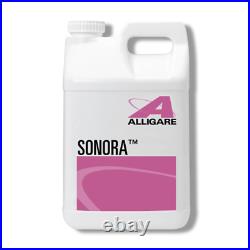Clopyralid 3 (Sonora) Herbicide 128oz- Transline or Reclaim Herbicide


Clopyralid herbicide is a selective herbicide used for controlling broadleaf weeds, particularly in turf and certain agricultural settings. It is known for its systemic action, which means it is absorbed through the foliage and then transported throughout the plant to effectively control weeds from the inside out. Clopyralid is the common name for 3,6-dichloro-2-pyridinecarboxylic acid, a compound that acts as a synthetic auxin. This type of herbicide mimics natural plant hormones, disrupting growth processes and causing the plant to die. It is particularly effective against perennial and annual broadleaf weeds. How to Use Clopyralid Herbicide. When using clopyralid herbicide, it is essential to follow the label instructions carefully.
The product should be mixed with water and applied using suitable spray equipment. It is crucial to apply the herbicide when weeds are actively growing and to ensure thorough coverage for the best results.
Where to Apply Clopyralid Herbicide. Clopyralid can be applied in various settings, including non-residential turf, such as golf courses and commercial landscapes, and in agricultural fields. It is not recommended for use on residential turf lawns.Additionally, it should not be used in areas where the soil is highly permeable, particularly where the water table is shallow, to prevent potential groundwater contamination. Weeds Labeled for Control with Clopyralid Herbicide.
Clopyralid is effective against a range of broadleaf weeds, including but not limited to. It is also used in the management of noxious weeds, such as Canada thistle and knapweed, which are difficult to control with other herbicides.
The application rate of clopyralid herbicide varies depending on the target weed and the area being treated. For example, the label may specify a rate of 0.38 lb ae clopyralid per acre for certain uses. In Florida and New York, the maximum use rate is 0.25 lb ae clopyralid per acre per growing season. It is important to adhere to the label's specified rates to avoid damage to non-target plants and to comply with legal restrictions.Wear protective clothing, including gloves, long sleeves, long pants, and eye protection. Avoid inhalation of spray mist and contact with skin or eyes. Keep people and pets out of the treated area until the spray has dried.
Do not apply near water bodies or in a manner that may contaminate water through drift or runoff. Follow all grazing and haying restrictions as specified on the label to protect livestock. Do not use plant residues or manure from treated areas for composting or mulching where susceptible plants may be grown the following season. Clopyralid has been known to persist in plant material and manure.
Therefore, it is important not to use plant residues, including hay or straw from treated areas, or manure from animals that have grazed or consumed forage from treated areas for composting or mulching where susceptible plants may be grown the following season. Clopyralid herbicide is a powerful tool for managing broadleaf weeds in non-residential turf and certain agricultural settings. Its effectiveness, however, comes with the responsibility to use it judiciously and in accordance with label instructions to minimize risks to the environment and non-target species. Proper application techniques and adherence to safety guidelines will ensure that clopyralid remains a valuable asset in weed management programs.